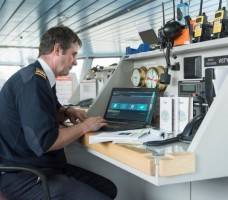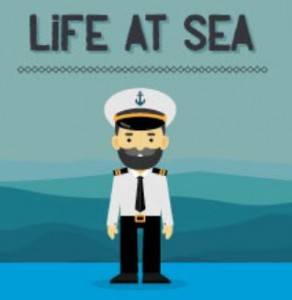 Tim Peake’s recent return home from space at the end of a six month stay in the International Space Station highlighted just how essential it is for people to stay in contact with their friends, family and the rest of the world, literally from wherever they may be. Of course, back on Earth we now take it for granted that we are in a state of constant connectedness to the rest of the world. So the idea of someone being out of contact, even for brief periods of time, strikes us as odd. Perhaps that partly explains our fascination with the experiences of astronauts and other people who cannot take connectivity for granted. But it’s not just astronauts who have to consider how to enjoy the connectedness that we normally assume to be ours by right. People who work at sea face the same challenge and you could argue that it is more important for such truly remote workers to be in contact with other people and the Internet. So who fares better when it comes to achieving connectivity?
Tim Peake’s recent return home from space at the end of a six month stay in the International Space Station highlighted just how essential it is for people to stay in contact with their friends, family and the rest of the world, literally from wherever they may be. Of course, back on Earth we now take it for granted that we are in a state of constant connectedness to the rest of the world. So the idea of someone being out of contact, even for brief periods of time, strikes us as odd. Perhaps that partly explains our fascination with the experiences of astronauts and other people who cannot take connectivity for granted. But it’s not just astronauts who have to consider how to enjoy the connectedness that we normally assume to be ours by right. People who work at sea face the same challenge and you could argue that it is more important for such truly remote workers to be in contact with other people and the Internet. So who fares better when it comes to achieving connectivity?
The Space Race
 In 2010, NASA enhanced the quality of life of astronauts with the release of a special software update that allowed them personal access to the internet. Expedition 22’s Flight Engineer, T.J. Creamer was the first to use the intergalactic internet, posting the following tweet:”Hello Twitterverse! We r now LIVE tweeting from the International Space Station – the 1st live tweet from Space! 🙂 More soon, send your ?s”
In 2010, NASA enhanced the quality of life of astronauts with the release of a special software update that allowed them personal access to the internet. Expedition 22’s Flight Engineer, T.J. Creamer was the first to use the intergalactic internet, posting the following tweet:”Hello Twitterverse! We r now LIVE tweeting from the International Space Station – the 1st live tweet from Space! 🙂 More soon, send your ?s”
While the internet may ease the isolation of space, it doesn’t offer the quickest connection, as a result of the distance signals have to travel. In 2015, astronaut Scott Kelly tweeted while in space: “We have a slow internet connection. Worse than what dial-up was like. Using it to answer your question right now”. When an astronaut in space clicks a link, the request travels 22,000 miles to a network of geosynchronous satellites. This is passed to a receiver on the ground before being passed back to the astronaut’s laptop or tablet.
According to NASA spokesman, David Steitz, astronauts have laptops on board, including one in their personal sleeping quarters. They are also given tablet computers so they can video chat with family and friends at home. Astronauts can even phone calls from space too, although the technology is a lot more complicated than a standard landline. Astronauts can call friends and family using the Softphone, specialist software found on laptops. By using Internet Protocol (IP), signals are routed from space to Earth. Astronauts can dial numbers through the computer’s keypad and speak through a headset.
All at Sea
 For those at sea, the issue of connectivity now has its own regulations and a market has opened up for systems that offer solutions for the world’s remotest workforce such as those from Global Navigation Solutions. The Maritime Labour Convention 2006 advises that ship operators should give crews “reasonable access to ship-to-shore telephone communications, and email and Internet facilities, where available, with any charges for the use of these services being reasonable in amount”.
For those at sea, the issue of connectivity now has its own regulations and a market has opened up for systems that offer solutions for the world’s remotest workforce such as those from Global Navigation Solutions. The Maritime Labour Convention 2006 advises that ship operators should give crews “reasonable access to ship-to-shore telephone communications, and email and Internet facilities, where available, with any charges for the use of these services being reasonable in amount”.
But just how closely are operators following these guidelines? Between April and August 2015, the 2015 Crew Connectivity Survey was carried out to establish what crew communications at sea are really like. This matters because while an astronaut might spend six months in space, a ship’s crew spends over 7 months per year at sea on average. Crews are even less well connected than astronauts.
 It found that 58 percent of respondents said they had access to crew communications always or most of the time — this is up 2 percent on 2014’s results. However, 35 percent of respondents only have access sometimes. 7 percent have never had access while on-board. While this may seem a small percentage, it equates to 103,000 global seafarers who have no way of contacting loved ones — up 25,000 since 2014.
It found that 58 percent of respondents said they had access to crew communications always or most of the time — this is up 2 percent on 2014’s results. However, 35 percent of respondents only have access sometimes. 7 percent have never had access while on-board. While this may seem a small percentage, it equates to 103,000 global seafarers who have no way of contacting loved ones — up 25,000 since 2014.
When it came to gauging the communications tools offered to crew, the survey found:
• 79 percent had access to satellite telephone (voice calling). This is the most widely available method of communication. In some sectors, this figure drops to just 70 percent.
• Only 43 percent had internet access.
• 42 percent had access to text only emails.
• 28 percent had access to onboard GSM. GSM stands for Global System for Mobile communication and is a digital mobile telephony system.
• 24 percent had access to SMS messaging.
The report also emphasises that on land, we can stay connected almost anywhere, with the exception of mountain peaks and remote locations. However, at sea, it’s a very different story.
• 47 percent can access crew communications on the ship’s bridge
• Just 36 percent of respondents can access crew communications in their cabin — this is the only place crew members can communicate privately.
• 35 percent can access crew communications in a communal area
• 29 percent can access crew communications in an on-board office
• 13 percent can access crew communications in the engine control room
Even when these services are available, it can be that crew members don’t use them. The Most common answers cited for this in the report are:
• 59 percent said the services are too expensive
• 27 percent said too many people are trying to use them
• 26 percent said they don’t get regular use
• Only 18 percent said nothing limits their use.
Employers can help to overcome at least one of these objections by offering crew free access to some services. However this is far from universal and employers offer them on only select forms of communication.
• Text only email — 53 percent
• Internet access — 49 percent
• Email with attachments — 49 percent
• Video chat — 41 percent
• SMS messaging — 24 percent
• On-board GSM — 12 percent
• Satellite phone — 7 percent
The situation doesn’t necessarily improve when crews arrive in port. Nearly three-quarters (72 percent) never or rarely go ashore during port calls and just 6 percent are able to go ashore on every port call. Of those who do go ashore, 28 percent use crew welfare facilities while in port, 34 percent of whom usee internet/Wi-Fi services, 6 percent use the telephone and 4 percent purchase local SIM cards.
According to the report there is a slight advantage in being higher ranked. Around a third (32 percent) of officers always have access to crew communications while just a quarter (27 percent) of ratings always have access.
So, how effective has the Maritime Labour Convention 2006 been? On the whole, the majority believe crew communications has improved. However, 39 percent said it had not improved since it was introduced and 3 percent said it had even got worse.
A Verdict
So, who has the better deal in terms of communication? Crew or Astronaut
 The results seem definitive. Despite orbiting the earth thousands of miles away, astronauts are more connected than the crew sailing the seas on our own planet. Despite being 400km away from Earth, ISS astronauts are better connected than sailors who travel the 361 million square km of our planet’s oceans.
The results seem definitive. Despite orbiting the earth thousands of miles away, astronauts are more connected than the crew sailing the seas on our own planet. Despite being 400km away from Earth, ISS astronauts are better connected than sailors who travel the 361 million square km of our planet’s oceans.
Sources
Crew Connectivity 2015 Survey Report — https://www.futurenautics.com/crewconn15
Quote from Maritime Labour Convention https://www.ilo.org/dyn/normlex/en/f?p=NORMLEXPUB:91:0::::P91_SECTION:MLC_A3
https://www.theatlantic.com/technology/archive/2015/06/the-internet-in-space-slow-dial-up-lasers-satellites/395618/
https://www.nasa.gov/home/hqnews/2010/jan/HQ_M10-012_ISS_Web.html
https://www.nasa.gov/vision/space/livinginspace/Now_Thats_A_Long-Distance_Call.html
https://www.physicalgeography.net/fundamentals/8o.html
https://searchmobilecomputing.techtarget.com/definition/GSM
https://www.nasa.gov/centers/johnson/pdf/569954main_astronaut percent20_FAQ.pdf
https://www.nasa.gov/audience/forstudents/5-8/features/oceans-the-great-unknown-58.html














July 5, 2016
Sea and space: the final frontiers for remote working and connectivity 0
by Neil Franklin • Case studies, Comment, Knowledge, Legal news, Technology
The Space Race
 In 2010, NASA enhanced the quality of life of astronauts with the release of a special software update that allowed them personal access to the internet. Expedition 22’s Flight Engineer, T.J. Creamer was the first to use the intergalactic internet, posting the following tweet:”Hello Twitterverse! We r now LIVE tweeting from the International Space Station – the 1st live tweet from Space! 🙂 More soon, send your ?s”
In 2010, NASA enhanced the quality of life of astronauts with the release of a special software update that allowed them personal access to the internet. Expedition 22’s Flight Engineer, T.J. Creamer was the first to use the intergalactic internet, posting the following tweet:”Hello Twitterverse! We r now LIVE tweeting from the International Space Station – the 1st live tweet from Space! 🙂 More soon, send your ?s”
While the internet may ease the isolation of space, it doesn’t offer the quickest connection, as a result of the distance signals have to travel. In 2015, astronaut Scott Kelly tweeted while in space: “We have a slow internet connection. Worse than what dial-up was like. Using it to answer your question right now”. When an astronaut in space clicks a link, the request travels 22,000 miles to a network of geosynchronous satellites. This is passed to a receiver on the ground before being passed back to the astronaut’s laptop or tablet.
According to NASA spokesman, David Steitz, astronauts have laptops on board, including one in their personal sleeping quarters. They are also given tablet computers so they can video chat with family and friends at home. Astronauts can even phone calls from space too, although the technology is a lot more complicated than a standard landline. Astronauts can call friends and family using the Softphone, specialist software found on laptops. By using Internet Protocol (IP), signals are routed from space to Earth. Astronauts can dial numbers through the computer’s keypad and speak through a headset.
All at Sea
 For those at sea, the issue of connectivity now has its own regulations and a market has opened up for systems that offer solutions for the world’s remotest workforce such as those from Global Navigation Solutions. The Maritime Labour Convention 2006 advises that ship operators should give crews “reasonable access to ship-to-shore telephone communications, and email and Internet facilities, where available, with any charges for the use of these services being reasonable in amount”.
For those at sea, the issue of connectivity now has its own regulations and a market has opened up for systems that offer solutions for the world’s remotest workforce such as those from Global Navigation Solutions. The Maritime Labour Convention 2006 advises that ship operators should give crews “reasonable access to ship-to-shore telephone communications, and email and Internet facilities, where available, with any charges for the use of these services being reasonable in amount”.
But just how closely are operators following these guidelines? Between April and August 2015, the 2015 Crew Connectivity Survey was carried out to establish what crew communications at sea are really like. This matters because while an astronaut might spend six months in space, a ship’s crew spends over 7 months per year at sea on average. Crews are even less well connected than astronauts.
When it came to gauging the communications tools offered to crew, the survey found:
• 79 percent had access to satellite telephone (voice calling). This is the most widely available method of communication. In some sectors, this figure drops to just 70 percent.
• Only 43 percent had internet access.
• 42 percent had access to text only emails.
• 28 percent had access to onboard GSM. GSM stands for Global System for Mobile communication and is a digital mobile telephony system.
• 24 percent had access to SMS messaging.
The report also emphasises that on land, we can stay connected almost anywhere, with the exception of mountain peaks and remote locations. However, at sea, it’s a very different story.
• 47 percent can access crew communications on the ship’s bridge
• Just 36 percent of respondents can access crew communications in their cabin — this is the only place crew members can communicate privately.
• 35 percent can access crew communications in a communal area
• 29 percent can access crew communications in an on-board office
• 13 percent can access crew communications in the engine control room
Even when these services are available, it can be that crew members don’t use them. The Most common answers cited for this in the report are:
• 59 percent said the services are too expensive
• 27 percent said too many people are trying to use them
• 26 percent said they don’t get regular use
• Only 18 percent said nothing limits their use.
Employers can help to overcome at least one of these objections by offering crew free access to some services. However this is far from universal and employers offer them on only select forms of communication.
• Text only email — 53 percent
• Internet access — 49 percent
• Email with attachments — 49 percent
• Video chat — 41 percent
• SMS messaging — 24 percent
• On-board GSM — 12 percent
• Satellite phone — 7 percent
The situation doesn’t necessarily improve when crews arrive in port. Nearly three-quarters (72 percent) never or rarely go ashore during port calls and just 6 percent are able to go ashore on every port call. Of those who do go ashore, 28 percent use crew welfare facilities while in port, 34 percent of whom usee internet/Wi-Fi services, 6 percent use the telephone and 4 percent purchase local SIM cards.
According to the report there is a slight advantage in being higher ranked. Around a third (32 percent) of officers always have access to crew communications while just a quarter (27 percent) of ratings always have access.
So, how effective has the Maritime Labour Convention 2006 been? On the whole, the majority believe crew communications has improved. However, 39 percent said it had not improved since it was introduced and 3 percent said it had even got worse.
A Verdict
So, who has the better deal in terms of communication? Crew or Astronaut
Sources
Crew Connectivity 2015 Survey Report — https://www.futurenautics.com/crewconn15
Quote from Maritime Labour Convention https://www.ilo.org/dyn/normlex/en/f?p=NORMLEXPUB:91:0::::P91_SECTION:MLC_A3
https://www.theatlantic.com/technology/archive/2015/06/the-internet-in-space-slow-dial-up-lasers-satellites/395618/
https://www.nasa.gov/home/hqnews/2010/jan/HQ_M10-012_ISS_Web.html
https://www.nasa.gov/vision/space/livinginspace/Now_Thats_A_Long-Distance_Call.html
https://www.physicalgeography.net/fundamentals/8o.html
https://searchmobilecomputing.techtarget.com/definition/GSM
https://www.nasa.gov/centers/johnson/pdf/569954main_astronaut percent20_FAQ.pdf
https://www.nasa.gov/audience/forstudents/5-8/features/oceans-the-great-unknown-58.html